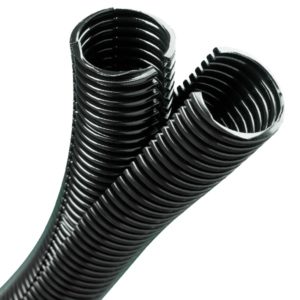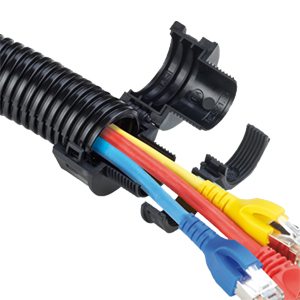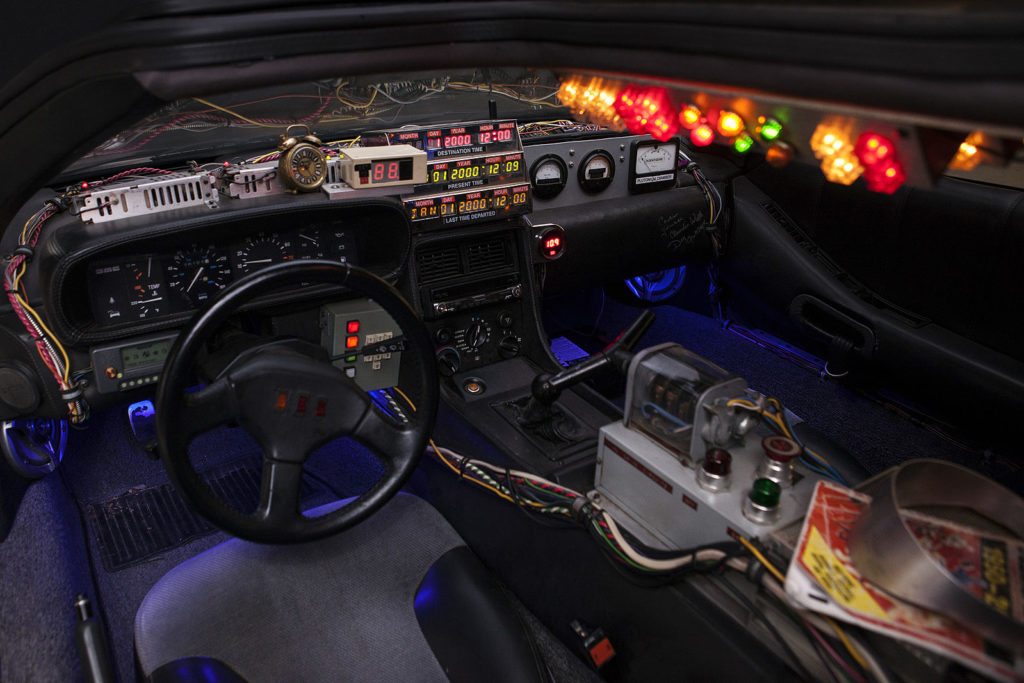How to Select Cable Protection for Automotive Applications
Five Things to Keep in Mind When Selecting Cable Protection for Automotive Applications
George Sims, Director of Marketing, AerosUSA
1. Sealed or Open System
One of the first things to consider when selecting cable protection for automotive applications is whether the cables can operate effectively and reliably with no to minimal protection or whether they require protection from environmental elements or application hazards like high flexure.
Traditional automotive split loom is light-wall and very flexible and, as such, tends to peel open when over-flexed or exposed to high vibration. This can allow debris such as water, sand, mud, salt, road dirt, debris, and rocks to enter the wire harness, resulting in damage above and beyond that incurred due to application demands and wear over time. Consequently, automotive looms are typically covered with tape to help seal off the conduit and prevent at least some such issues. However, the taping process requires a lot of extra handling and adds a tremendous amount of labor to the harness build, which increases the overall cost, as well as reduces the functionality of the harness. Additionally, since traditional automotive loom is made of lightweight material, it doesn’t offer adequate protection on high-end vehicle harnesses, including those employed in military ground support vehicles, heavy construction equipment, and commercial vehicles like snow plows and transit buses.
Sealed cable protection systems — IP66 for light splashing or IP68/69K for high-pressure wash-downs — keep wire harnesses free of debris and protect them from premature degradation and failure. Sealed polyamide cable protection systems are especially robust and provide much greater protection and longer service lifetimes than even taped traditional automotive loom. They are also available in a variety of polyamide materials with different features and flammability ratings, allowing engineers to specify the proper material depending on the location of the harness and the application at hand, and can facilitate retrofit installations
 Figure 1: ROHRflex-Duo-PA 6 two-piece, reclosable, flexible conduit from AerosUSA is crush-resistant, flame retardant, self extinguishing, resistant to chemicals including gasoline, and retrofittable, making it an ideal solution for demanding automotive applications.
Figure 1: ROHRflex-Duo-PA 6 two-piece, reclosable, flexible conduit from AerosUSA is crush-resistant, flame retardant, self extinguishing, resistant to chemicals including gasoline, and retrofittable, making it an ideal solution for demanding automotive applications.
2. Location of Harness
Another thing to consider is the location of the harness. Harnesses near the engine compartment, catalytic convertor, or transmission typically require high-temperature polyamide protection. Products with ratings of -40°C to +115°C are widely available, and specialty products rated for use at temperatures as high as 200°C and even 300°C are available as well. Harnesses inside of the vehicle can use less robust protective materials; however, a divisible or retrofittable conduit system could still be beneficial to enhance the ease of adding additional wires for add-on features, such as Wi-FI and lighting.
3. Material Selection
Polyamide cable protection systems come in a variety of material compositions, allowing users to select products ideally suited to their specific application. Light- and medium-wall products are best suited for basic applications that aren’t exposed to the elements or rough handling. For demanding, harsh environment applications, users can select heavy-wall polyamide cable protection systems made from materials with high-impact and high-temperature resistance, UL94 V-0 compliance for low-smoke, low-toxicity performance in passenger zone areas that must comply with ASTM and Bombardier specifications for flammability, and high flexibility for resistance to continuous motion, which is common in robotics applications. Robust polyamide cable protection systems can also offer high flexibility combined with high impact resistance, which is useful in applications including the jumper cables that link vehicles like subway cars, oversized diameters of up to 4’’ to protect large bundles of cables, and divisible and retrofittable capabilities that allow users to add or remove wires during a vehicle’s prototype build or service life.
4. Cable Protection System Accessories
An excellent cable protection system should also have a wide selection of accessories to complement the conduits and allow users to achieve a complete, efficient, and effective installation. There are myriad accessories designed to enhance performance in virtually every application, including: fittings with built-in strain relief, snap-in fittings for high-speed production, female-threaded fittings designed to mate with military style commercial grade 5015 connectors, Y and T junction fittings, clamps, abrasion rings, end sleeves, divisible lock nuts, and divisible fittings for retrofit applications.
 Figure 2: A split lock-nut fitting allows users to securely mount cables without having to make critical connections in the field, which is useful in pre-loomed automotive applications that require both protection and the ability to add new cabling for enhanced functionality.
Figure 2: A split lock-nut fitting allows users to securely mount cables without having to make critical connections in the field, which is useful in pre-loomed automotive applications that require both protection and the ability to add new cabling for enhanced functionality.
5. Longevity of System
Lastly, it’s important to consider how long an automotive cable protection system will need to be warrantied. The quality and reputation of the vehicle should also be reflected in the conduits selected to protect the wiring harness to ensure parallel performance. High-end military and commercial vehicles can cost upwards of $1 million and can’t afford to have wiring harnesses fail prematurely.






